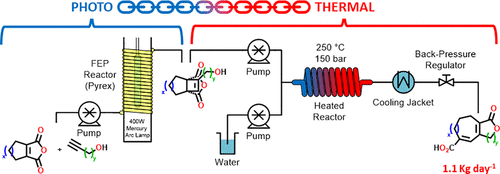当前位置:
X-MOL 学术
›
Org. Process Res. Dev.
›
论文详情
Our official English website, www.x-mol.net, welcomes your
feedback! (Note: you will need to create a separate account there.)
Integrated Multistep Photochemical and Thermal Continuous Flow Reactions: Production of Bicyclic Lactones with Kilogram Productivity
Organic Process Research & Development ( IF 3.1 ) Pub Date : 2021-09-08 , DOI: 10.1021/acs.oprd.1c00089 Rowena A. Howie 1 , Luke D. Elliott 2 , Surajit Kayal 1 , Xue-Zhong Sun 1 , Magnus W. D. Hanson-Heine 1 , Jonathan Hunter 1 , Charlotte A. Clark 1 , Ashley Love 1 , Christopher Wiseall 1 , Darren S. Lee 1 , Martyn Poliakoff 1 , Kevin I. Booker Milburn 2 , Michael W. George 1
Organic Process Research & Development ( IF 3.1 ) Pub Date : 2021-09-08 , DOI: 10.1021/acs.oprd.1c00089 Rowena A. Howie 1 , Luke D. Elliott 2 , Surajit Kayal 1 , Xue-Zhong Sun 1 , Magnus W. D. Hanson-Heine 1 , Jonathan Hunter 1 , Charlotte A. Clark 1 , Ashley Love 1 , Christopher Wiseall 1 , Darren S. Lee 1 , Martyn Poliakoff 1 , Kevin I. Booker Milburn 2 , Michael W. George 1
Affiliation

|
Combining continuous photochemistry and flow reactions in high-temperature/high-pressure water has enabled us to integrate a multistep sequence into a single process with a reduction in reaction time to <10 min compared to >24 h in batch. At the same time, applying this approach to different substrates has allowed us to increase previously low yields to levels high enough to make these reactions potentially useful for multistage synthesis. In this paper, we describe the [2 + 2] cycloaddition/fragmentation of 3,4,5,6-tetrahydrophthalic anhydride and propargyl alcohol and analogous compounds leading to bicyclic lactones to demonstrate how photochemistry and thermal chemistry can be combined using continuous flow techniques to create complex structures on a relatively large scale. We show how photochemical and high-temperature water flow reactors can be used to carry out a three-step reaction sequence as a single integrated and continuous process. The reaction time has been reduced by exploiting the enhanced acidity of high-temperature water/acetonitrile mixtures. The overall process is demonstrated on an equivalent productivity of a >1 kg/day productivity using lab-scale equipment. Our approach should be simple to scale up in an appropriate facility, for larger scale production of chemicals. Process analytical technology and modeling were used to support the reaction development, while UV and IR time-resolved spectroscopies have been used to provide a deeper understanding of the reaction mechanism.
中文翻译:

集成的多步光化学和热连续流动反应:以千克生产率生产双环内酯
将高温/高压水中的连续光化学和流动反应相结合,使我们能够将多步序列集成到单个过程中,与批量处理 >24 小时相比,反应时间减少到 <10 分钟。同时,将这种方法应用于不同的底物使我们能够将以前的低产率提高到足够高的水平,使这些反应有可能用于多阶段合成。在本文中,我们描述了 3,4,5,6-四氢邻苯二甲酸酐和炔丙醇以及类似化合物的 [2 + 2] 环加成/断裂,从而产生了双环内酯,以展示如何使用连续流动技术将光化学和热化学结合起来以相对较大的规模创建复杂的结构。我们展示了如何使用光化学和高温水流反应器将三步反应序列作为单个集成和连续过程进行。通过利用高温水/乙腈混合物增强的酸度,缩短了反应时间。使用实验室规模的设备,以大于 1 公斤/天的生产率证明了整个过程。我们的方法应该很容易在适当的设施中扩大规模,以实现更大规模的化学品生产。过程分析技术和建模被用来支持反应的发展,而紫外和红外时间分辨光谱被用来提供对反应机理的更深入的理解。通过利用高温水/乙腈混合物增强的酸度,缩短了反应时间。使用实验室规模的设备,以大于 1 公斤/天的生产率证明了整个过程。我们的方法应该很容易在适当的设施中扩大规模,以实现更大规模的化学品生产。过程分析技术和建模被用来支持反应的发展,而紫外和红外时间分辨光谱被用来提供对反应机理的更深入的理解。通过利用高温水/乙腈混合物增强的酸度,缩短了反应时间。使用实验室规模的设备,以大于 1 公斤/天的生产率证明了整个过程。我们的方法应该很容易在适当的设施中扩大规模,以实现更大规模的化学品生产。过程分析技术和建模被用来支持反应的发展,而紫外和红外时间分辨光谱被用来提供对反应机理的更深入的理解。用于更大规模的化学品生产。过程分析技术和建模被用来支持反应的发展,而紫外和红外时间分辨光谱被用来提供对反应机理的更深入的理解。用于更大规模的化学品生产。过程分析技术和建模被用来支持反应的发展,而紫外和红外时间分辨光谱被用来提供对反应机理的更深入的理解。
更新日期:2021-09-17
中文翻译:

集成的多步光化学和热连续流动反应:以千克生产率生产双环内酯
将高温/高压水中的连续光化学和流动反应相结合,使我们能够将多步序列集成到单个过程中,与批量处理 >24 小时相比,反应时间减少到 <10 分钟。同时,将这种方法应用于不同的底物使我们能够将以前的低产率提高到足够高的水平,使这些反应有可能用于多阶段合成。在本文中,我们描述了 3,4,5,6-四氢邻苯二甲酸酐和炔丙醇以及类似化合物的 [2 + 2] 环加成/断裂,从而产生了双环内酯,以展示如何使用连续流动技术将光化学和热化学结合起来以相对较大的规模创建复杂的结构。我们展示了如何使用光化学和高温水流反应器将三步反应序列作为单个集成和连续过程进行。通过利用高温水/乙腈混合物增强的酸度,缩短了反应时间。使用实验室规模的设备,以大于 1 公斤/天的生产率证明了整个过程。我们的方法应该很容易在适当的设施中扩大规模,以实现更大规模的化学品生产。过程分析技术和建模被用来支持反应的发展,而紫外和红外时间分辨光谱被用来提供对反应机理的更深入的理解。通过利用高温水/乙腈混合物增强的酸度,缩短了反应时间。使用实验室规模的设备,以大于 1 公斤/天的生产率证明了整个过程。我们的方法应该很容易在适当的设施中扩大规模,以实现更大规模的化学品生产。过程分析技术和建模被用来支持反应的发展,而紫外和红外时间分辨光谱被用来提供对反应机理的更深入的理解。通过利用高温水/乙腈混合物增强的酸度,缩短了反应时间。使用实验室规模的设备,以大于 1 公斤/天的生产率证明了整个过程。我们的方法应该很容易在适当的设施中扩大规模,以实现更大规模的化学品生产。过程分析技术和建模被用来支持反应的发展,而紫外和红外时间分辨光谱被用来提供对反应机理的更深入的理解。用于更大规模的化学品生产。过程分析技术和建模被用来支持反应的发展,而紫外和红外时间分辨光谱被用来提供对反应机理的更深入的理解。用于更大规模的化学品生产。过程分析技术和建模被用来支持反应的发展,而紫外和红外时间分辨光谱被用来提供对反应机理的更深入的理解。











































 京公网安备 11010802027423号
京公网安备 11010802027423号